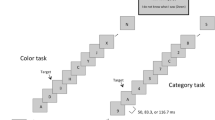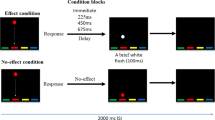Abstract
Perceptual processing in autism is associated with both ‘strengths’ and ‘weaknesses’ but within a literature that varies widely in terms of the assessments used. We report data from 12 children with autism spectrum disorders (ASD) and 12 age and IQ matched neurotypical controls tested on a set of tasks using the same stimuli throughout but systematically changing in difficulty. These tasks ranged through simple detection of stimulus onset to pairwise size discrimination across two approaching targets. Children with ASD were slower than controls even in simple detection tasks, but this did not explain further group differences found in the size discrimination of approaching targets. The results are discussed in terms of impairments in speed of responding in ASD under certain conditions of visuomotor coupling, stimulus presentation and increased information processing demands.







Similar content being viewed by others
Notes
We do not use this term in the same sense as Greenaway and Plaisted (2005) and reserve it for describing a stimulus under continuous change.
Although the processing of and attending to faces has been found to be problematic in ASD, Rosset et al. (2008) found that ASD and TD children respond in similar ways to cartoon faces.
Full counterbalancing of all variables manipulated in the videos produced too many possible combinations.
No participants were deemed outliers according to task accuracy.
These two participants were not unusual with respect to IQ relative to the rest of their respective group.
Effect size estimates were calculated by dividing the Mann–Whitney U statistic by the product of the two group sample sizes.
References
Adams, N. C., & Jarrold, C. (2012). Inhibition in autism: Children with autism have difficulty in inhibiting irrelevant distractors but not prepotent responses. Journal of Autism and Developmental Disorders, 42(6), 1052–1063.
Ames, C., & Fletcher-Watson, S. (2010). A review of methods in the study of attention in autism. Developmental Review, 30(1), 52–73.
Borghi, A. M., & Scorolii, C. (2004). Language comprehension and dominant hand motion simulation. Human Movement Science, 28(1), 12–27.
Bott, L., Brock, J., Brockdorff, N., Boucher, J., & Lamberts, K. (2006). Perceptual similarity in autism. The Quarterly Journal of Experimental Psychology, 59(7), 1237–1254.
Burack, J. A. (1994). Selective attention deficits in persons with autism: Preliminary evidence of an inefficient attentional lens. Journal of Abnormal Psychology, 103(3), 535–543.
Christ, S. E., Holt, D. D., White, D. A., & Green, L. (2007). Inhibitory control in children with autism spectrum disorder. Journal of Autism and Developmental Disorders, 37(6), 1155–1165.
Courchesne, E., Townsend, J., Akshoomoff, N. A., Saitoh, O., Yeung-Courchesne, R., Lincoln, A. J., et al. (1994). Impairment in shifting attention in autistic and cerebellar patients. Behavioral Neuroscience, 108(5), 848–865.
Dakin, S. C., & Frith, U. (2005). Vagaries of visual perception in autism. Neuron, 48, 497–507.
Dennis, M., Francis, D. J., Cirino, P. T., Schachar, R., Barnes, M. A., & Fletcher, J. M. (2009). Why IQ is not a covariate in cognitive studies of neurodevelopmental disorders. Journal of the International Neuropsychological Society, 15(3), 331–343.
Frith, U. (2003). Autism: Explaining the enigma. Malden, Mass: Blackwell.
Gepner, B., & Feron, F. (2009). Autism: A world changing too fast for a mis-wired brain. Neuroscience and Biobehavioral Reviews, 33, 1227–1242.
Geurts, H. M., Verte, S., Oosterlaan, J., Roeyers, H., & Sergeant, J. A. (2004). How specific are executive functioning deficits in attention deficit hyperactivity disorder and autism? Journal of Child Psychology and Psychiatry, 45(4), 836–854.
Goldberg, M. C., Mostofsky, S. H., Cutting, L. E., Mahone, E. M., Astor, B. C., Denckla, M. B., et al. (2005). Subtle executive impairments in children with autism and children with ADHD. Journal of Autism and Developmental Disorders, 35(3), 279–293.
Goldstein, G., Allen, D. N., Minshew, N. J., Williams, D. L., Volkmar, F., Klin, A., et al. (2008). The structure of intelligence in children and adults with high functioning autism. Neuropsychology, 22(3), 301–312.
Goldstein, G., Johnson, C., & Minshew, N. J. (2001). Attentional processes in autism. Journal of Autism and Developmental Disorders, 31(4), 433–440.
Gonzalez, C., Martin, J. M., Minshew, N. J., & Behrmann, M. (2013). Practice makes improvement: How adults with autism out-perform others in a naturalistic visual search task. Journal of Autism and Developmental Disorders, 43(10), 2259–2268.
Greenaway, R., & Plaisted, K. (2005). Top-down attentional modulation in autistic spectrum disorders is stimulus-specific. Psychological Science, 16(12), 987–993.
Grissom, R. J., & Kim, J. J. (2012). Effect sizes for research: Univariate and multivariate applications (2nd ed.). New York, NY: Taylor & Francis.
Grubb, M. A., Behrmann, M., Egan, R., Minshew, N. J., Carrasco, M., & Heeger, D. J. (2013). Endogenous spatial attention: Evidence for intact functioning in adults with autism. Autism Research, 6, 108–118.
Happe, F., & Frith, U. (Eds.). (2010). Autism and talent. Oxford: Oxford University Press.
Jarrold, C., Gilchrist, I. D., & Bender, A. (2005). Embedded figures detection in autism and typical development: Preliminary evidence of a double dissociation in relationships with visual search. Developmental Science, 8(4), 344–351.
Johnson, K. A., Robertson, I. H., Kelly, S. P., Silk, T. J., Barry, E., Daibhis, A., et al. (2007). Dissociation in performance of children with ADHD and high-functioning autism on a task of sustained attention. Neuropsychologia, 45(10), 2234–2245.
Joliffe, T., & Baron-Cohen, S. (1997). Are people with autism and Asperger syndrome faster than normal on the embedded figures test? Journal of Child Psychology and Psychiatry, 38, 52–5347.
Joseph, R. M., Keehn, B., Connolly, C., Wolf, J. M., & Horowitz, T. S. (2009). Why is visual search superior in autism spectrum disorder? Developmental Science, 12(6), 1083.
Kaufman, A. S., & Kaufman, N. L. (2004). Kaufman assessment battery for children: Second edition (KABC-II). Circle Pines, MN: AGS Publishing.
Mann, T., & Walker, P. (2003). Autism and a deficit in broadening the spread of visual attention. Journal of Child Psychology and Psychiatry, 44(2), 274–284.
McGonigle-Chalmers, M., Bodner, K., Fox-Pitt, A., & Nicholson, L. (2008). Size sequencing as a window on executive control in children with autism and Asperger’s syndrome. Journal of Autism and Developmental Disorders, 38(7), 1382–1390.
Minshew, N. J., Luna, B., & Sweeney, J. A. (1999). Oculomotor evidence for neocortical systems but not cerebellar dysfunction in autism. Neurology, 52(5), 917–922.
Mottron, L., Belleville, S., & Menard, E. (1999). Local bias in autistic subjects as evidenced by graphic tasks: Perceptual hiearchization or working memory deficit? Journal of Child Psychology and Psychiatry, 40(5), 743–755.
O’Hearn, K., Asato, M., Ordaz, S., & Luna, B. (2008). Neurodevelopment and executive dysfunction in autism. Development and Psychopathology, 20, 1103–1132.
Pascualvaca, D. M., Fantie, B. D., Papageorgiou, M., & Mirsky, A. F. (1998). Attentional capacities in children with autism: Is there a general deficit in shifting focus? Journal of Autism and Developmental Disorders, 28(6), 467–477.
Pennington, B. F., & Ozonoff, S. (1996). Executive functions and developmental psychopathology. Journal of Child Psychology and Psychiatry, 37(1), 51–87.
Plaisted, K. (2001). Reduced generalization in autism: An alternative to weak central coherence. In J. A. Burack, T. Charman, N. Yirmiya, & P. R. Zelazo (Eds.), The development of autism: Perspectives from theory and research (pp. 149–169). Mahwah, N J: Lawrence Erlbaum Associates.
Plaisted, K., O’Riordan, M., & Baron-Cohen, S. (1998). Enhanced discrimination of novel, highly similar stimuli by adults with autism during a perceptual learning task. Journal of Child Psychology and Psychiatry, 39(5), 765–775.
Purcell, C., Wann, J. P., Wilmut, K., & Poulter, D. (2012). Reduced looming sensitivity in primary school children with developmental co-ordination disorder. Developmental Science, 15(3), 299–306.
Ronconi, L., Gori, S., Ruffono, M., Moltemi, M., & Facoetti, A. (2013). Zoom-out attentional impairment in children with autism spectrum disorder. Cortex, 49(4), 1025–1033.
Rosset, D. B., Rondan, C., Da Fonseca, D., Santos, A., Assouline, B., & Deruelle, C. (2008). Typical emotion processing for cartoon but not for real faces in children with autism spectrum disorders. Journal of Autism and Developmental Disorders, 38, 919–925.
Sachse, M., Schlitt, S., Hainz, D., Ciaramidaro, A., Schirman, S., Walter, H., et al. (2013). Executive and visuo-motor function in adolescents and adults with autism spectrum disorder. Journal of Autism and Developmental Disorders, 43(5), 1222–1235.
Schmitz, N., Daly, E., & Murphy, D. (2007). Frontal anatomy and reaction time in autism. Neuroscience Letters, 412, 12–17.
Schomaker, J., & Talsa, D. (2009). The relationship between response time and the strength of top-down attentional control: An ERP study. Journal of European Psychology Students, 1, 1–7.
Shah, A., & Frith, U. (1983). An islet of ability in autistic children: A research note. Journal of Child Psychology and Psychiatry, 24, 613–620.
Sussman, E., Winkler, I., & Schroger, E. (2003). Top-down control over involuntary attention switching in the auditory modality. Psychonomic Bulletin & Review, 10(3), 630637.
Tsatsanis, K. D. (2005). Neuropsychological characteristics in Autism and related conditions. In F. R. Volkmar, R. Paul, A. Klin, & D. Cohen (Eds.), Handbook of autism and pervasive developmental disorders (3rd ed., pp. 365–381). New York: Wiley.
Wainwright, J. A., & Bryson, S. K. (1996). Visual-spatial orienting in autism. Journal of Autism and Developmental Disorders, 26(4), 423–438.
Walter, E., Dassonville, P., & Bochsler, T. M. (2009). A specific autistic trait that modulates visuospatial illusion susceptibility. Journal of Autism and Developmental Disorders, 39(2), 339–349.
Acknowledgments
The first author would like to acknowledge a Kerr-Fry Award in support of the MSc from which this work originated. We would also like to thank all of the participants and their families and schools.
Author information
Authors and Affiliations
Corresponding author
Rights and permissions
About this article
Cite this article
Miller, L., McGonigle-Chalmers, M. Exploring Perceptual Skills in Children with Autism Spectrum Disorders: From Target Detection to Dynamic Perceptual Discrimination. J Autism Dev Disord 44, 1144–1157 (2014). https://doi.org/10.1007/s10803-013-1977-6
Published:
Issue Date:
DOI: https://doi.org/10.1007/s10803-013-1977-6




